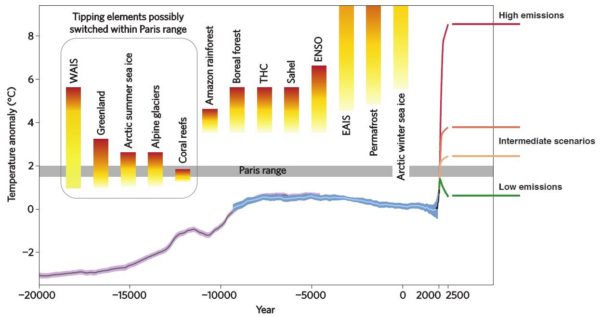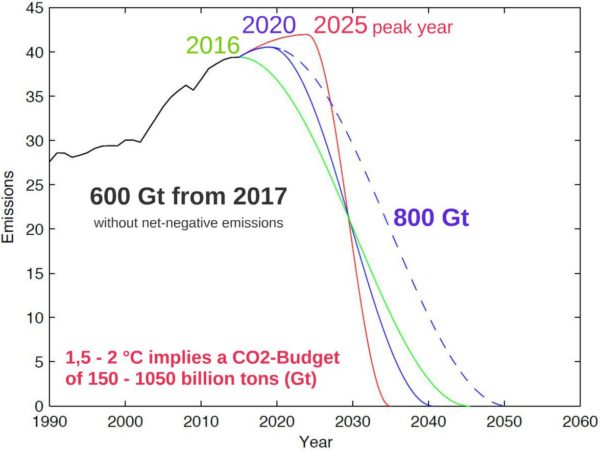(by Stefan Rahmstorf and Anders Levermann)
In the landmark Paris Climate Agreement, the world’s nations have committed to “holding the increase in the global average temperature to well below 2 °C above pre-industrial levels and to pursue efforts to limit the temperature increase to 1.5 °C above pre-industrial levels”. This goal is deemed necessary to avoid incalculable risks to humanity, and it is feasible – but realistically only if global emissions peak by the year 2020 at the latest.
Let us first address the importance of remaining well below 2°C of global warming, and as close to 1.5°C as possible. The World Meteorological Organization climate report[i] for the past year has highlighted that global temperature and sea levels keep rising, reaching record highs once again in 2016. Global sea ice cover reached a record low, and mountain glaciers and the huge ice sheets in Greenland and Antarctica are on a trajectory of accelerating mass loss. More and more people are suffering from increasing and often unprecedented extreme weather events[ii], both in terms of casualties and financial losses. This is the situation after about 1°C global warming since the late 19th Century.
Not only will these impacts get progressively worse as warming continues, but our planet also runs a growing risk of crossing critical tipping points where major and largely irreversible changes to the Earthsystem are triggered (see Fig. 1).

Fig. 1 Tipping elements in the Earth system, in relation to past global temperature evolution since the last Ice Age 20,000 years ago as well as future warming scenarios[iii]. The Paris range of 1.5 – 2 °C warming is shown in grey; the bars show increasing risk of crossing tipping points from yellow to red.
The West Antarctic Ice Sheet (WAIS in Fig. 1) has likely already been destabilised, committing the world to at least three meters of global sea-level rise in coming centuries[iv] – an outcome that scientists have warned about since the 1970s[v]. The Greenland Ice Sheet – holding enough ice to eventually raise global sea levels by seven meters – may likewise be destabilised below 2°C[vi]. Coral reefs have suffered pan-tropical mass bleaching in 2016 and are doing so again in 2017 as a result of warming oceans, and only if global temperature stays well below 2°C some remnants of the world’s coral reefs can be saved[vii]. The Gulf Stream system (THC in Fig. 1) appears to be already slowing[viii] and recent research indicates it is far more unstable than previously thought.
Because overall global temperature rise depends on cumulative global CO2 emissions, the Paris temperature range can be translated, with some uncertainty, into a budget of CO2emissions that are still permissible. This is the overall budget for the century and it lies within the range of 150 to 1050 Gt of CO2, based on updated numbers from IPCC[ix]. At the current global emission level of 39 GtCO2 per year, the lower limit of this range would be crossed in less than four years and is thus already unachievable without massive application of largely unproven and speculative carbon dioxide removal technologies. Even the CO2 budget corresponding to the mid-point of this uncertainty range, 600 GtCO2, is equivalent to only 15 years of current emissions. Fig. 2 illustrates three scenarios with this budget and different peaking years for global emissions. It makes clear that even if we peak in 2020 reducing emissions to zero within twenty years will be required. By assuming a more optimistic budget of 800 Gt this can be stretched to thirty years, but at a significant risk of exceeding 2°C warming.
It is still possible therefore to meet the Paris temperature goals if emissions peak by 2020 at the latest, and there are signs to show we are moving in that direction as global CO2 emissions have not increased for the past three years. We will need an enormous amount of action and scaled up ambition to harness the current momentum in order to travel down the decarbonisation curve at the necessary pace; the window to do that is still open[x].
In summary, declining carbon emissions after 2020 is a necessity for meeting the Paris temperature limit of “well below 2 degrees”.

Fig. 2 Three illustrative scenarios for spending the same budget of 600 Gt CO2, with emissions peaking in 2016 (green), 2020 (blue) and 2025 (red), and an alternative with 800 Gt (dashed).
Note: This article first appeared in the report 2020 The Climate Turning Point
References
[i] World Meteorological Organisation. WMO Statement on the State of the Global Climate in 2016 (WMO, Geneva, 2017).
[ii] World Meteorological Organisation. Weather extremes in a changing climate: hindsight on foresight (WMO, Geneva, 2011).
[iii] Schellnhuber, H. J., Rahmstorf, S. & Winkelmann, R. Why the right climate target was agreed in Paris. Nature Climate Change 6, 649-653 (2016). doi:10.1038/nclimate3013
[iv] Feldmann, J. & Levermann, A. Collapse of the West Antarctic Ice Sheet after local destabilization of the Amundsen Basin. Proc Natl Acad Sci U S A 112, 14191-6 (2015). doi:10.1073/pnas.1512482112
[v] Mercer, J. West Antarctic ice sheet and CO2 greenhouse effect: a threat of disaster. Nature 271, 321-325 (1978).
[vi] Robinson, A., Calov, R. & Ganopolski, A. Multistability and critical thresholds of the Greenland ice sheet. Nature Climate Change 2, 429-432 (2012). doi:10.1038/nclimate1449
[vii] Frieler, K. et al. Limiting global warming to 2 degrees C is unlikely to save most coral reefs. Nature Climate Change 3, 165-170 (2013). doi:Doi 10.1038/Nclimate1674
[viii] Rahmstorf, S. et al. Exceptional twentieth-century slowdown in Atlantic Ocean overturning circulation. Nature Climate Change 5, 475-480 (2015). doi:10.1038/nclimate2554
[ix] Peters, G. How much carbon dioxide can we emit? (2017) http://cicero.uio.no/en/posts/climate/how-much-carbon-dioxide-can-we-emit.
[x] A Roadmap for Rapid Decarbonization. Science, March 24, 2017: Johan Rockström, Owen Gaffney, Joeri Rogelj, Malte Meinshausen, Neboja Nakicenovic, Hans Joachim Schellnhuber http://www.sciencemagazinedigital.org/sciencemagazine/24_march_2017?pg=33#pg33
Andrew @197
The critical point is that the Keeling curve has to head downwards rather than continue upwards. For this to happen the action on curbing emissions has to change by an order of magnitude. But as Al Bundy @198 and JR @199 point out, humanity has probably blown it.
Re: #201 Digby
“The critical point is that the Keeling curve has to head downwards rather than continue upwards. For this to happen the action on curbing emissions has to change by an order of magnitude.”
No. Actually for the Keeling curve to “head downwards” (in other words for the atmospheric concentration of CO2 to decrease), mathematically what is necessary is that CO2 emissions < natural sinks + whatever CO2 sequestration humanity manages to implement.
But neither the Paris Agreement nor the article above by Stefan Rahmstorf and Anders Levermann are concerned directly with having the Keeling Curve "head downward". They are concerned with keeping temperatures "far below 2C", something already difficult enough to achieve.
You and mike and some others here are "moving the goalposts" to justify your unrealistic, misinformed negative criticism of the Paris agreement.
Andrew @202
You baffle me. From the time I first became interested in the topic a decade ago I’ve always thought that the ultimate measure of success would be a declining Keeling curve. I’ve never moved goalposts.
I’ve got nothing against the Paris agreement. If it achieves the above goal, I’d be perfectly happy.
It’s obvious that won’t happen. Emissions will continue to grow past 2020. China’s INDC calls for doubling by 2030.
So what are the implications of this emissions increase past 2020? Will there be a declaration that the 2C target is no longer possible?
Re: #203 Digby
“From the time I first became interested in the topic a decade ago I’ve always thought that the ultimate measure of success would be a declining Keeling curve.”
Again, this is magic thinking, just like counting on Gen IV nuclear reactors which only exist on paper to help fight climate change.
How do you propose to have “a declining Keeling curve” without first:
1. Peaking global CO2 emissions.
2. Reducing global CO2 emissions.
3. Reaching net zero global CO2 emissions.
And how do you propose achieving 1, 2 and 3 without an international agreement about emissions reductions that most if not all countries will comply with? And how do you propose to have most if not all countries comply with such as agreement except voluntarily?
You are “baffled” by simple math and basic logic, perhaps?
Re: #204 MikeN
“It’s obvious that won’t happen. Emissions will continue to grow past 2020.”
Really? How do you know for sure? Oh, I see, you are just … guessing …
“China’s INDC calls for doubling by 2030.”
Ironically enough, China is by far the country that is investing the most into renewables and trying the hardest to decrease its use of coal for electricity generation. So singling them out as the one reason why we can’t globally peak emissions by 2020 is stupidly misleading.
How about having the rich and ultra-rich in the US and other developed countries reduce their carbon emissions by 50% by 2020, by imposing a carbon fee + dividend system (that would have the added simultaneous benefits of slightly redistributing income and encouraging the development of renewable energy and electric transportation)?
“So what are the implications of this emissions increase past 2020?”
If your guess comes true, and global emissions don’t peak in 2020, then the urgency in implementing public policies to 1. peak emissions as soon as possible, 2. reduce emissions as quickly as possible and 3. achieve net zero emissions as soon as possible, just increases.
“Will there be a declaration that the 2C target is no longer possible?”
There is a special report on the 1.5C threshold coming out sometime in 2018:
http://www.ipcc.ch/report/sr15/
#204–No, China’s INDC does not “call for doubling by 2030”–not, at least, if by ‘doubling’ you mean doubling carbon emissions. It calls for an emissions *peak* by 2030, with an emissions intensity reduction of 60-65%. That’s compatible with many different emissions trajectories.
https://globalcarbonpricing.com/2015/07/03/chinas-indc-2/
China’s INDC itself:
http://www4.unfccc.int/submissions/INDC/Published%20Documents/China/1/China's%20INDC%20-%20on%2030%20June%202015.pdf
(English text follows the Chinese version.)
It’s worth noting, too, that the language promises a ‘best effort’ to peak *before* 2030.
And in the real world (or at least something that purports to have a reasonable relationship therewith):
https://insideclimatenews.org/news/28022017/chinas-co2-reduction-clean-energy-trump-us
“China said its CO2 emissions in 2017 will drop 1 percent from 2016, making it the fourth consecutive year of either zero growth or a decline in the country’s emissions… China’s total energy consumption grew 1.4 percent in 2016 while CO2 emissions stayed flat, in part because of a 12 percent growth in clean energy development.”
And Climate Action Tracker’s assessment:
http://www.climateactiontracker.org/countries/china
206: “Really? How do you know for sure? Oh, I see, you are just … guessing …”
An educated guess based on balance of probability and current trends.
We have done nothing to reduce emissions in the last 50 years. Why should I believe that the trend will reverse within the next two and a half years?
It appears increasingly clear that we will blow through the 2 C goal. Utterly unrealistic emissions declines and huge quantities of carbon capture seem to be required to meet it. At about 36.25 gt per year of current GHG emmissions, we need (assuming a budget of 600 GT) to be cutting emissions at about 3% per year starting in 2017. It isn’t happening and, while I expect GHG emissions to decline over the next decade I’d be surprised if that decline is more than about 15%. (Power generation will see a slow and continuous decline as coal is phased out and natural gas leaks reduced. Land transport will see a significant decline as well as hybrids replace internal combustion engines. These processes are slow and leave out major emitting sectors.)
I would expect that we exceed the mid-point of the carbon budget here in about 20 years.
We need to be thinking about adapting to at least 3C of global warming. (And yes, that causes real and severe problems.)